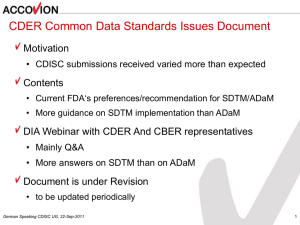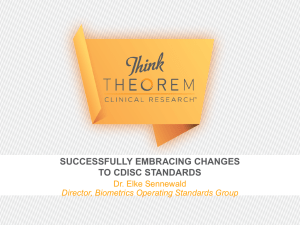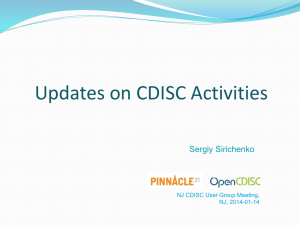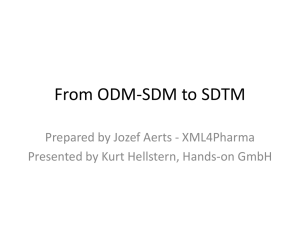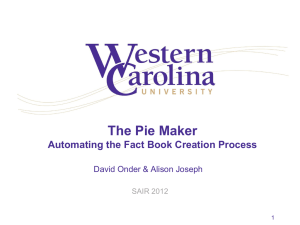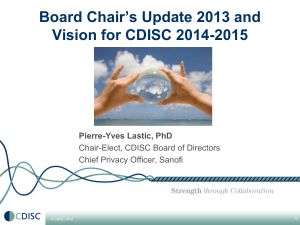02-German_CDISC_UG_Presentation_25SEP2012
advertisement
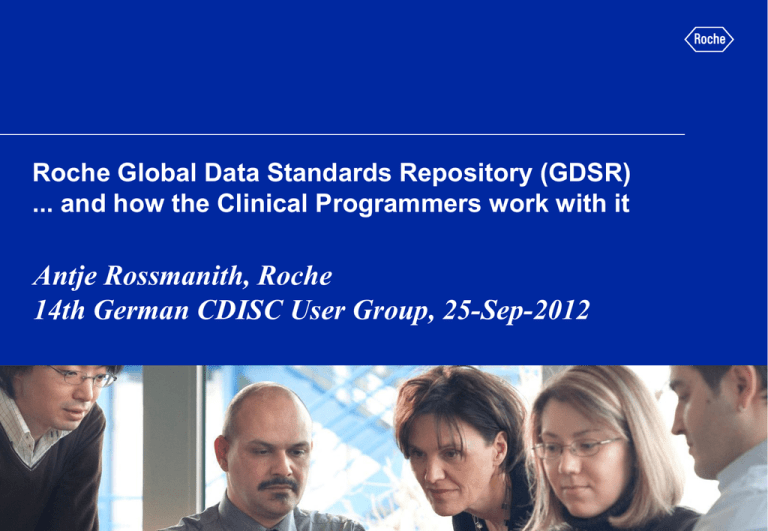
Roche Global Data Standards Repository (GDSR) ... and how the Clinical Programmers work with it Antje Rossmanith, Roche 14th German CDISC User Group, 25-Sep-2012 Overview 1. SDTM programming framework at Roche 2. Global Data Standards Repository (GDSR) browser 3. Data Tabulation Extract Excel spreadsheet 4. LB mapping 5. Conformance check tool 1. SDTM programming framework at Roche (1) • Source data from Rave Database available as SAS datasets • Programming framework for SDTM mapping – Excel Specification Templates – SAS Program Templates – Excel Controlled Terminology – SAS Macros (e.g. conversion into ISO8601, transposing, creating --SEQ variables, BL flags, etc.) 1. SDTM programming framework at Roche (2) • Excel Specification Templates are defined with information from the GDSR – target domain definition (including Roche defined SUPPQUAL variables) – mapping rules from Roche standard source data to SDTM • Excel Controlled Terminology is built from the Controlled terminology in GDSR – contains CDISC submission values – contains mapping from source values to SDTM – used by the Clinical Programmer to create SAS formats 2. Global Data Standards Repository (GDSR) browser (1) • If Roche standard data collection is used in a study, specification templates are used for SDTM mapping • Template development not ready yet • If no template available, GDSR browser is used to manually find the mapping rules 2. Global Data Standards Repository (GDSR) browser (2) 3. Data Tabulation Extract Excel spreadsheet • The GDSR content can be exported to an Excel Sheet • Advantage of the Excel export: target (SDTM domain) oriented, while browser is source oriented • Used to manually look up Value Level Metadata (e.g. LB, QS) • If no Excel Specification Template available, used to create Specification (target domain definition) • For outsourced studies: given to external vendors as reference for Roche implementation of CDISC, e.g. Sponsor defined domains, sponsor extension of Controlled Terminology, SUPPQUALs 4. LB mapping (1) • Three Lab metadata tables from GDSR used for SDTM mapping – Lab Standards – Preferred Units – Unit Conversions • Set of SAS macros in the programming framework which access these tables and automate the mapping from the Roche code to SDTM • Tables are not accessed directly from GDSR, they are extracted on a regular basis as .CSV files into the programming area • New requests for Lab tests, units, conversions are submitted by the Clinical Programmer via a ticketing system and then added to the GDSR 4. LB mapping (2) Lab Standards table 4. LB mapping (3) Preferred units table 4. LB mapping (4) Unit Conversions table Conversions independent from Lab parameter Conversions depending on Lab parameter 5. Conformance check tool • In development - status: pilot is planned • Based on Open CDISC • Includes checks against CDISC standards and extended Roche standards in GDSR Any questions? We Innovate Healthcare
